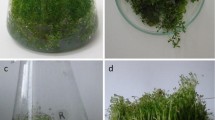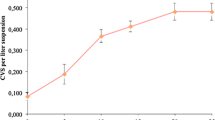The growth characteristics of P. peltatum suspension cell culture and the accumulation dynamics of phenolic compounds at different stages of cultivation were studied to assess the possibility of obtaining podophyllotoxin required to produce etoposide. It was shown that the biomass of fruit culture increased daily by 25%; of leaf bud, 23%; and of root, 13%. The biomasses of fruit and leaf bud cultures doubled in 3 d; of root culture, in 5 d. Cells obtained from fruit, buds, and roots used 18, 24, and 22% of the substrate for biomass formation and 82, 76, and 78%, respectively, for respiration. The initial acidity of the liquid nutrient medium was 5.58 ± 0.05. The pH of the suspension culture decreased by 5 d to 3.51 – 4.13, then rose and reached approximately the acidity values of the pure growth medium without inoculum in the bud, fruit, and root cultures by 20, 25, and 40 d, respectively. Then, the pH increased in suspension cultures of bud and fruit and decreased in suspension culture of root. Flavonoid and gallic acid derivatives were identified in all extracts. It was shown that a 10 – 15-day cell culture of P. peltatum obtained at the All-Russian Scientific Research Institute of Medicinal and Aromatic Plants could be considered an alternative source of podophyllotoxin and a source of a complex extract of phenolic compounds with antitumor activity.






Similar content being viewed by others
References
C. E. Vickers, J. Gershenzon, M. Lerdau, and F. Loreto, Nat. Chem. Biol., 5, 283 – 291 (2009).
S. Fares, E. Oksanen, M. Lannenpaa, et al., Photosynth. Res., 104, 61 – 74 (2010).
G. Wu, Sci. Rep., 6 (2016).
S. W. Jeong, et al., J. Adv. Res., 6, 493 – 499 (2015).
M. Shamloo, E. A. Babawale, A. Furtado, et al., Sci. Rep., 7(1), 9133 (2017).
M. Kluska and K. Wozniak, Int. J. Mol. Sci., 22, 6602 (2021).
State Pharmacopoeia of the USSR, VIIIth Ed., Moscow (1959).
R. R. Muradkhanov, Nauchn. Vedomosti BelGU, 16, No. 135, 146 – 151 (2012).
H. Lata, C. S. Mizuno, and R. M. Moraes, Methods Mol. Biol., 547, 387 – 402 (2009).
M. P. Kitaeva, A. A. Aksenov, T. A. Fedotcheva, et al., Khim.-farm. Zh., 56(3), 29 – 33 (2022); Pharm. Chem. J., 56(3), 361 – 365 (2022).
M. T. Engstrom, M. Palijarvi, and J.-P. Salminen, J. Agric. Food Chem., 63(16), 4068 – 4079 (2015).
V. V. Kuznetsov, V. V. Kuznetsova, and G. A. Romanova (eds.), Molecular-Genetic and Biochemical Methods in Modern Plant Biology [in Russian], BINOM, Laboratoriya Znanii, Moscow (2012).
Author information
Authors and Affiliations
Corresponding author
Additional information
Translated from Khimiko-Farmatsevticheskii Zhurnal, Vol. 57, No. 1, pp. 24 – 28, January, 2023.
Rights and permissions
Springer Nature or its licensor (e.g. a society or other partner) holds exclusive rights to this article under a publishing agreement with the author(s) or other rightsholder(s); author self-archiving of the accepted manuscript version of this article is solely governed by the terms of such publishing agreement and applicable law.
About this article
Cite this article
Kitaeva, M.P., Aksenov, A.A., Fedotcheva, T.A. et al. Changes in the Contents of Podophyllotoxin and other Phenolic Compounds in Acetone Extracts of Suspension Cell Cultures of Podophyllum peltatum L. at Different Stages of Cultivation. Pharm Chem J 57, 70–74 (2023). https://doi.org/10.1007/s11094-023-02852-x
Received:
Published:
Issue Date:
DOI: https://doi.org/10.1007/s11094-023-02852-x




